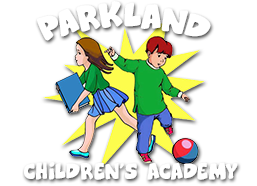
Learning how to differentiate between colors may not seem like a crucial task, but this skill will later develop into letter recognition, sight word recognition, and other higher-level sorting techniques. At Parkland Children’s Academy, we handle introducing colors in much the same way as we handle other subjects – lots of exposure in as many different ways as possible. Tying in hands-on exploration, we give your child the opportunity to use color recognition in their everyday lives.
Here are some examples of colorful preschool activities that can be done at home and in the classroom:
Color-Per-Day
Assign a color to each day, and have your child wear at least one item of clothing in that color. You can have pink Wednesdays, blue Fridays, or any other combination.
Playing With Paint
Paint is one of the first things that come to mind when one thinks of color, so it’s no surprise that it is where we begin when starting to teach different colors. Paint also ties into sensory play – which is crucial for brain development and readies them for “big” school.
Giant Color Wheel
An activity that often holds the ‘class favorite’ trophy, is creating a giant color wheel filled with objects found anywhere at all. To make a giant color wheel you will need:
- Large paper/cardstock
- Different colored paints
- Objects of all different colors – found at home, in the garden, etc.
- Glue
Start by putting the paper into a circle, and dividing it into even-sized wedges (like a pizza).
Next, have the children paint each wedge a different color of the rainbow, and let it dry completely.
Finally, take the objects that the children brought and have them match it to the wedge with the same color and glue them down.
Mixing Primary Colors
Sometimes the number of colors that a child has to learn can feel overwhelming at the beginning, so this is a nice way to ease into the color-discovery process.
Give your child paint in the primary colors (red, yellow, blue). Have them practice saying what each color is when they use it.
Now encourage them to mix the three colors in different ways to form new colors like orange, green, and purple. Have them say the name of each new color they make.
You can ask them to make the same color as the grass outside, and they can experiment and figure out how the colors work together to make new ones.
Get Moving
Some children respond better to activities that allow them to move around or use their hands while learning. Here are some fun color-games that they can play:
Color Scavenger Hunt
Taking a couple of containers (preferably with handles), you can paint or stick on paper in various colors. Each container will be of a different color.
Send your child around the house or toy-box with a container and have them fill the container with objects of that color. Once one container is full, let them find the other colors and fill the remaining containers.
This can easily be incorporated into the giant color wheel activity by sending a few items from each container to school with them the next day.
Simon Says
Adapting the classic game of Simon Says to incorporate colors is a simple way to keep color-learning full of movement. This game follows the same rules as the regular game, but instructions must only be followed if your child is wearing an item of clothing that is the color Simon calls out.
For example, “Simon Says everyone wearing green must touch their toes.”
Rainbow Pasta Necklaces
Making pasta necklaces, or pasta bracelets incorporates fine motor skills and encourages creativity.
First, we need to dye some pasta. Rigatoni is easy to dye – just soak the pieces in liquid food coloring and leave them to dry for a day or two.
Find some pipe cleaners to put the pasta on to. A string would work here too, but it can be more challenging to work with because it’s so floppy! See how your child manages either one and switch it over if they’re finding it too easy or too hard.
You can make alternating color patterns, necklaces with one color only, necklaces with a repeating pattern of three, or make a rainbow (red, orange, yellow, green, blue, indigo, violet).
I Spy
Another classic game – I Spy With My Little Eye is a wonderful way to get children looking for colors in the objects around them.
For example, “I spy with my little eye, something yellow.”
Mixing, And More Mixing
There are so many options for color mixing (not including paint), and they all engage your child’s senses differently. Examples of some things to play around with are:
- Water and food coloring
- Modeling clay
- Playdough
- Sand
At Parkland Children’s Academy, we love to play and learn at the same time! For more information on our preschool programs, contact us today at 954-688-5877.
